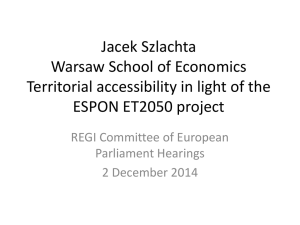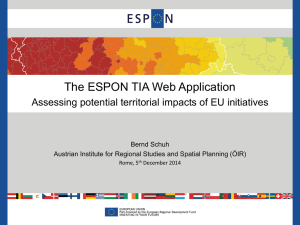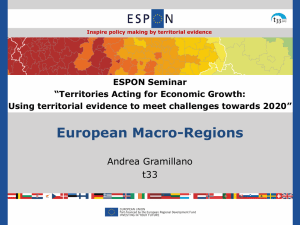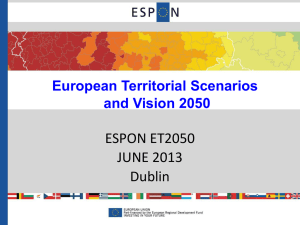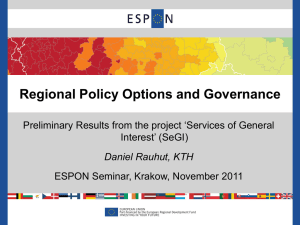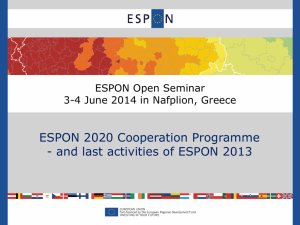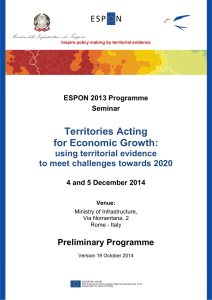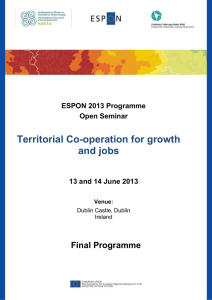presentation on ESPON
advertisement
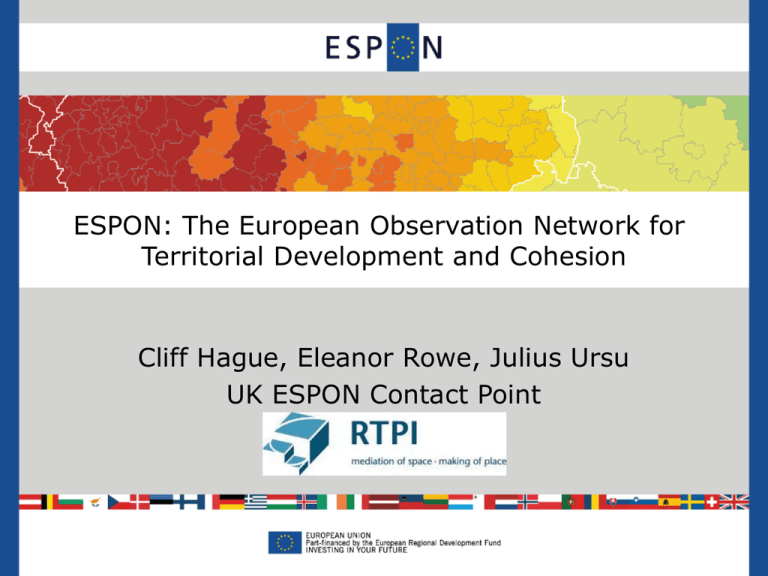
ESPON: The European Observation Network for Territorial Development and Cohesion Cliff Hague, Eleanor Rowe, Julius Ursu UK ESPON Contact Point ESPON 2002-2006 Getting data – a major challenge in ESPON 2006 ESPON 2006 concentrated on getting and mapping comparable data for all 29 countries and producing indicators. Time series data was a particular problem. ESPON produced snapshots of Europe based on the most recent data available at NUTS 2 and NUTS3 level. Key findings from ESPON 2006 • Europe’s highly developed ”core” was spreading along development corridors; • There were some regions outside the core that perform well on measures of competitiveness – e.g. in Scandinavia. • There was strong growth in the capital city regions of the states that joined the EU in 2004 – this aids cohesion at the EU level, but the gap between these regions and other regions in these states was widening. ESPON and Territorial Cohesion • ESPON research was used in Territorial Cohesion Green Paper (2008). • Also in the Third, Fourth and Fifth Cohesion Reports. The Territorial Agenda of the EU • ESPON 2006 provided information for the document “The Territorial State and Perspectives of the EU” that was published in 2007 and informed the “Territorial Agenda of the EU” that was agreed that same year by ministers for spatial development from the member states. • ESPON 2013 similarly shaped the updates of these two documents in 2011. The main criticism of ESPON 2006 “Many planning practitioners found it hard to understand the impact on their daily planning activities” The scale was too broad for most planners. ESPON 2013 • As in ESPON 2006, the 2013 programme conducts research on a pan-European level, now covering 31 countries and also the Western Balkans and Turkey. • These “Applied Research” projects include work on cities and on climate change. Other Applied Research projects Amongst other 2013 Applied Research projects in which UK universities are partners in the TPG are: • Knowledge, Innovation & Territory (LSE and Cardiff University); • Secondary Growth Poles & Territorial Development in Europe (led by Liverpool John Moores University); • European Seas and Territorial Development (University of Liverpool); and • Attractiveness of European Regions & Cities (University of the West of England). UK case studies Many of the Applied Research projects include case studies of UK regions. For example: • North Yorkshire features in the DEMIFER project. The case study explores patterns of migration in the region. • Glasgow and its relationship with its hinterland are in the FOCI project. • London is being looked at as an example of a world city in the project on the Territorial Impact of Globalization on European Regions. EDORA – A UK-led 2013 Applied Research project Looked at diverse rural regions with differing potentials. Rural areas no longer synonymous with agriculture. Small/medium-sized towns are important for rural development. Depopulation and aging in remote rural regions. Targeted analyses and user demand Stakeholders involved in: • Definition of the project • Selection of the TPG • Steering the research • Provision of information • Application of the output • Dissemination of results ESPON pays the research costs - stakeholders cover only their personnel and travel costs. CAEE - A UK-led targeted analysis project CAEE: The case for agglomeration economies in Europe Lead Partner: Greater Manchester Commission for Economic Development, Employment and Skills Others partners: Dublin, Barcelona, Lyon Research by University of Manchester Other Targeted Analysis projects with a UK Stakeholder • The Potential of Rural Regions (PURR) has 3 UK stakeholders – North Yorkshire, Dumfries & Galloway and the Welsh Assembly Government. • London South Bank University are in the research team working on this project. • The RISE project is about developing regional integrated strategies. Birmingham City Council is the UK stakeholder. The University of Birmingham is in the research team. Scenarios • In ESPON 2006 there was a major project that explored Spatial Scenarios for Europe, comparing patterns for differing policy emphases on cohesion or competition. • Several of the Applied Research projects have developed scenarios to explore the implications for different regions and parts of Europe of trends or policy choices. • A new over-arching project on scenarios begins in 2012. Territorial Impact Assessment ESPON has led the field in developing assessments of the territorial impacts of EU policies. The TIPTAP project developed a methodology and applied it to Transport policy and the Common Agricultural Policy. Later ESPON TIA work Later work in ESPON 2013 on Territorial Impact Assessment has sought to build a more qualitative and easy to use methodology that can be used by practitioners to do ex-ante assessments that would anticipate impacts of policies while they are still being formulated. In contrast the work in ESPON 2006 and in TIPTAP was retrospective. Such approaches could be linked into EU Impact Assessment or used at national or regional level. ARTS and ETIA are examples of these projects. ESPON’s Scientific Platform • ESPON has also built a database. • It is producing an on-line Atlas that will allow inter-active use. • It has developed a typology of regions • There is a project on Indicators of Territorial Cohesion (INTERCO). ESPON INTERSTRAT – Disseminating ESPON • The RTPI is leading the work on the ESPON-Interstrat project. • The project partners are ECPs in Belgium, Bulgaria, Greece, Ireland, Italy, Poland, Romania and Slovenia. • It has produced materials on using ESPON in the UK. Key reports from ESPON 2013 ESPON UK Network • Set up by RTPI – but you can join it even if you are not an RTPI member. Visit www.espon.org.uk • It includes updates and news of ESPON and provides opportunities to exchange ideas and views. • It’s free – but you have to register to become a member • Contact research@rtpi.org.uk or ring +44(0)20 7929 9496. • The main ESPON website is www.espon.eu
